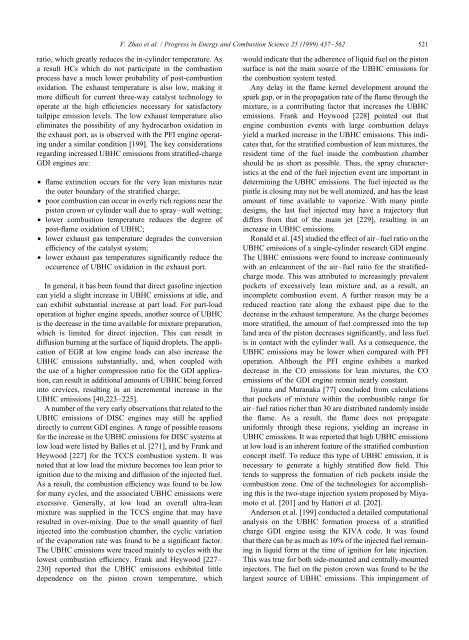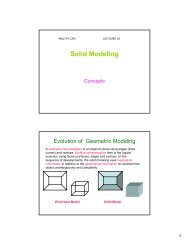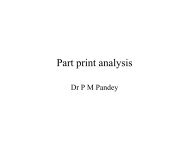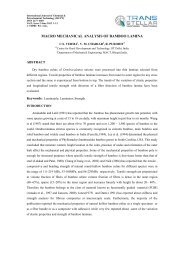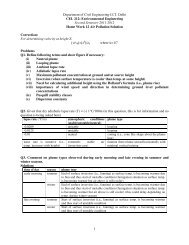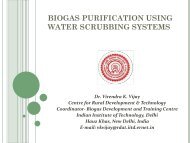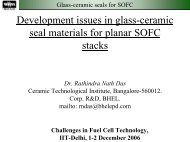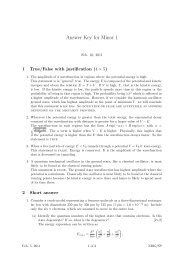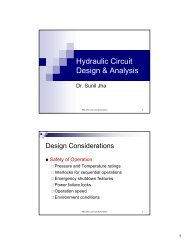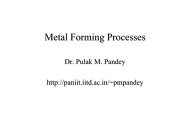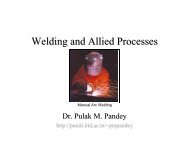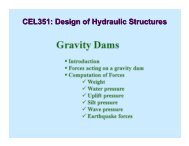Automotive spark-ignited direct-injection gasoline engines
Automotive spark-ignited direct-injection gasoline engines
Automotive spark-ignited direct-injection gasoline engines
Create successful ePaper yourself
Turn your PDF publications into a flip-book with our unique Google optimized e-Paper software.
F. Zhao et al. / Progress in Energy and Combustion Science 25 (1999) 437–562 521<br />
ratio, which greatly reduces the in-cylinder temperature. As<br />
a result HCs which do not participate in the combustion<br />
process have a much lower probability of post-combustion<br />
oxidation. The exhaust temperature is also low, making it<br />
more difficult for current three-way catalyst technology to<br />
operate at the high efficiencies necessary for satisfactory<br />
tailpipe emission levels. The low exhaust temperature also<br />
eliminates the possibility of any hydrocarbon oxidation in<br />
the exhaust port, as is observed with the PFI engine operating<br />
under a similar condition [199]. The key considerations<br />
regarding increased UBHC emissions from stratified-charge<br />
GDI <strong>engines</strong> are:<br />
• flame extinction occurs for the very lean mixtures near<br />
the outer boundary of the stratified charge;<br />
• poor combustion can occur in overly rich regions near the<br />
piston crown or cylinder wall due to spray–wall wetting;<br />
• lower combustion temperature reduces the degree of<br />
post-flame oxidation of UBHC;<br />
• lower exhaust gas temperature degrades the conversion<br />
efficiency of the catalyst system;<br />
• lower exhaust gas temperatures significantly reduce the<br />
occurrence of UBHC oxidation in the exhaust port.<br />
In general, it has been found that <strong>direct</strong> <strong>gasoline</strong> <strong>injection</strong><br />
can yield a slight increase in UBHC emissions at idle, and<br />
can exhibit substantial increase at part load. For part-load<br />
operation at higher engine speeds, another source of UBHC<br />
is the decrease in the time available for mixture preparation,<br />
which is limited for <strong>direct</strong> <strong>injection</strong>. This can result in<br />
diffusion burning at the surface of liquid droplets. The application<br />
of EGR at low engine loads can also increase the<br />
UBHC emissions substantially, and, when coupled with<br />
the use of a higher compression ratio for the GDI application,<br />
can result in additional amounts of UBHC being forced<br />
into crevices, resulting in an incremental increase in the<br />
UBHC emissions [40,223–225].<br />
A number of the very early observations that related to the<br />
UBHC emissions of DISC <strong>engines</strong> may still be applied<br />
<strong>direct</strong>ly to current GDI <strong>engines</strong>. A range of possible reasons<br />
for the increase in the UBHC emissions for DISC systems at<br />
low load were listed by Balles et al. [271], and by Frank and<br />
Heywood [227] for the TCCS combustion system. It was<br />
noted that at low load the mixture becomes too lean prior to<br />
ignition due to the mixing and diffusion of the injected fuel.<br />
As a result, the combustion efficiency was found to be low<br />
for many cycles, and the associated UBHC emissions were<br />
excessive. Generally, at low load an overall ultra-lean<br />
mixture was supplied in the TCCS engine that may have<br />
resulted in over-mixing. Due to the small quantity of fuel<br />
injected into the combustion chamber, the cyclic variation<br />
of the evaporation rate was found to be a significant factor.<br />
The UBHC emissions were traced mainly to cycles with the<br />
lowest combustion efficiency. Frank and Heywood [227–<br />
230] reported that the UBHC emissions exhibited little<br />
dependence on the piston crown temperature, which<br />
would indicate that the adherence of liquid fuel on the piston<br />
surface is not the main source of the UBHC emissions for<br />
the combustion system tested.<br />
Any delay in the flame kernel development around the<br />
<strong>spark</strong> gap, or in the propagation rate of the flame through the<br />
mixture, is a contributing factor that increases the UBHC<br />
emissions. Frank and Heywood [228] pointed out that<br />
engine combustion events with large combustion delays<br />
yield a marked increase in the UBHC emissions. This indicates<br />
that, for the stratified combustion of lean mixtures, the<br />
resident time of the fuel inside the combustion chamber<br />
should be as short as possible. Thus, the spray characteristics<br />
at the end of the fuel <strong>injection</strong> event are important in<br />
determining the UBHC emissions. The fuel injected as the<br />
pintle is closing may not be well atomized, and has the least<br />
amount of time available to vaporize. With many pintle<br />
designs, the last fuel injected may have a trajectory that<br />
differs from that of the main jet [229], resulting in an<br />
increase in UBHC emissions.<br />
Ronald et al. [45] studied the effect of air–fuel ratio on the<br />
UBHC emissions of a single-cylinder research GDI engine.<br />
The UBHC emissions were found to increase continuously<br />
with an enleanment of the air–fuel ratio for the stratifiedcharge<br />
mode. This was attributed to increasingly prevalent<br />
pockets of excessively lean mixture and, as a result, an<br />
incomplete combustion event. A further reason may be a<br />
reduced reaction rate along the exhaust pipe due to the<br />
decrease in the exhaust temperature. As the charge becomes<br />
more stratified, the amount of fuel compressed into the top<br />
land area of the piston decreases significantly, and less fuel<br />
is in contact with the cylinder wall. As a consequence, the<br />
UBHC emissions may be lower when compared with PFI<br />
operation. Although the PFI engine exhibits a marked<br />
decrease in the CO emissions for lean mixtures, the CO<br />
emissions of the GDI engine remain nearly constant.<br />
Iiyama and Muranaka [77] concluded from calculations<br />
that pockets of mixture within the combustible range for<br />
air–fuel ratios richer than 30 are distributed randomly inside<br />
the flame. As a result, the flame does not propagate<br />
uniformly through these regions, yielding an increase in<br />
UBHC emissions. It was reported that high UBHC emissions<br />
at low load is an inherent feature of the stratified combustion<br />
concept itself. To reduce this type of UBHC emission, it is<br />
necessary to generate a highly stratified flow field. This<br />
tends to suppress the formation of rich pockets inside the<br />
combustion zone. One of the technologies for accomplishing<br />
this is the two-stage <strong>injection</strong> system proposed by Miyamoto<br />
et al. [201] and by Hattori et al. [202].<br />
Anderson et al. [199] conducted a detailed computational<br />
analysis on the UBHC formation process of a stratified<br />
charge GDI engine using the KIVA code. It was found<br />
that there can be as much as 10% of the injected fuel remaining<br />
in liquid form at the time of ignition for late <strong>injection</strong>.<br />
This was true for both side-mounted and centrally-mounted<br />
injectors. The fuel on the piston crown was found to be the<br />
largest source of UBHC emissions. This impingement of


